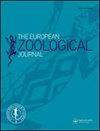极端环境下的饮食:维苏威火山上欧洲野兔的饮食
IF 1.6
4区 生物学
Q2 ZOOLOGY
引用次数: 1
摘要
摘要欧洲野兔(Lepus europaeus)是一种世界性的物种,生活在各种各样的栖息地,表现出多样化的饮食,主要来自农业草地和农作物,对极端环境的研究很少。在这里,我们首次描述了来自维苏威火山的欧洲野兔的饮食,使用DNA元条形码和高通量测序从粪便颗粒中提取的DNA,代表了生活在火山环境中的人口。通过高分辨率的融化分析,首先将颗粒中的DNA遗传分配给欧洲野兔。维苏威火山上的野兔以豆科的草本植物为主,占总食粮的86.26%。该物种最常摄取的植物是Galega officinalis和Lupinus angustifolius(占总膳食的67.10%),尽管这些植物在研究区域仅偶有发现。事实上,可用植物的光谱还包括其他容易获取的野生植物(如Lolium sp., Bromus sp., Rumex sp.)和栽培植物(如茄属番茄,甜瓜,Pisum sativum),这些植物仅在野兔的饮食中发现微量。我们的贡献增加了关于欧洲野兔营养生态学的信息,探索了它在极端环境下生活的能力。这可能有助于制定物种保护的管理策略,这与维苏威火山作为鸟类和哺乳动物的猎物以及通过内窥草选择性放牧的植被调节剂的生态学相关。此外,我们的研究代表了生活在不复存在的环境中的野兔饮食的最新信息:在我们采样后,一场大火摧毁了大约80%的树木区域。火灾后的再生正在改变原始环境,从而改变欧洲野兔的营养可用性。主要政策重点是国家公园生物多样性的保护欧洲野兔生态系统服务一种狐獴狩猎物种的管理本文章由计算机程序翻译,如有差异,请以英文原文为准。
Eating in an extreme environment: diet of the European hare (Lepus europaeus) on Vesuvius
Abstract The European hare (Lepus europaeus) is cosmopolitan species, living in a variety of habitats and showing a diversified diet, that has been described mainly from agricultural meadows and crops, with little information available for extreme environments. Here, we describe, for the first time, the diet of the European hare from Mount Vesuvius, using DNA metabarcoding and high-throughput sequencing on DNA extracted from faecal pellets, a proxy for a population living in a volcanic environment. The DNA from pellets was first genetically assigned to European hare using high-resolution melting analysis. The diet of the hare on Vesuvius is mainly composed of herbaceous species belonging to Fabaceae (86.26% of total diet). The most frequent plant items ingested by the species are Galega officinalis and Lupinus angustifolius (67.10% of total diet), although these are detected only sporadically in the study area. Indeed, the spectrum of available plants also includes other easily accessible wild (i.e. Lolium sp., Bromus sp., Rumex sp.) and cultivated (i.e. Solanum lycopersicum, Cucumis melo, Pisum sativum) plant items, found only in traces in the diet of the hares. Our contribution adds information on the trophic ecology of the European hare, exploring its ability to live in an extreme environment. This could be useful to set a management strategy for conservation of the species, which is ecologically relevant on Vesuvius as prey for birds and mammals, as well as a vegetation modulator via selective grazing by endozoochory. Furthermore, our study represents the latest information on the diet of the hare living in an environment that no longer exists: an extensive fire destroyed about 80% of the woody area after our sampling. The post-fire regrowth is transforming the original environment and consequently the trophic availability for the European hare. Key policy highlights Conservation of biodiversity in a national park Ecosystem service of the European hare Management of a Lagomorpha game species
求助全文
通过发布文献求助,成功后即可免费获取论文全文。
去求助
来源期刊

European Zoological Journal
Agricultural and Biological Sciences-Animal Science and Zoology
CiteScore
3.10
自引率
5.60%
发文量
80
审稿时长
30 weeks
期刊介绍:
The European Zoological Journal (previously Italian Journal of Zoology) is an open access journal devoted to the study of all aspects of basic, comparative and applied protozoan and animal biology at molecular, cellular, tissue, organ, organismal, population, and community-ecosystem level. Papers covering multiple levels of organization and integrative approaches to study animal form, function, development, ecology, evolution and systematics are welcome. First established in 1930 under the name of Il Bollettino di Zoologia, the journal now has an international focus, reflected through its global editorial board, and wide author and readership.
 求助内容:
求助内容: 应助结果提醒方式:
应助结果提醒方式:


